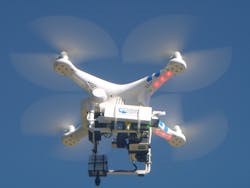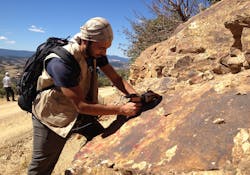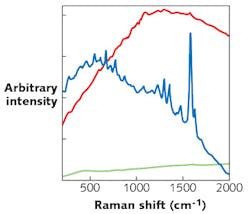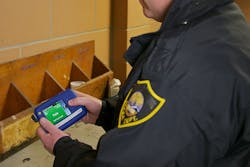Photonics Products: Handheld Spectrometers: How spectrometers have shrunk and grown since 2010
Handheld spectrometers, representing a middle-range spectroscopy capability compared to larger benchtop systems and tiny, narrowband chip-scale spectral engines such as ring resonator designs, continue to shrink in size and/or weight and yet grow in terms of measurement capability as trends in optics and sensor miniaturization continue within the photonics industry.
Whether an application requires a visible-light spectrometer, a Fourier-transform infrared (FTIR) instrument that does not experience the autofluorescence that can hinder Raman detection, or a Raman spectrometer to see through the spectral water peak of liquid samples, there is an abundance of handheld spectrometer manufacturers competing for the business of a seemingly endless list of customers that grows even longer with each performance improvement and price reduction.
Smaller, faster, better
"Our customers have inspired us to make ever-smaller spectroscopy instrumentation. They appreciate how miniaturization makes it easier to take the spectrometer to the sample, and to integrate the spectrometer into other devices," says Rob Morris, marketing operations manager at Ocean Optics (Dunedin, FL). "Since 2010, customer expectations are no longer about whether the device will work, but whether it will work as well as a laboratory-grade integrated benchtop spectrometer. 'Smaller, faster, better' are now basic assumptions with customers on how instruments evolve."
Morris says that the Ocean Optics Spark is a small spectral sensor operating from 380 to 700 nm that bridges the spectral measurement gap between filter-based devices such as RGB color sensors and CCD-array instruments such as miniature spectrometers by producing a digitized spectrum from a 1024-pixel array. Thermally stable over a -10°–60°C operating range and with signal-to-noise ratio (SNR) of 1500:1 and 4.5–9.0 nm full-width half-maximum (FWHM) resolution, Spark—as its customers expect—can be used for all types of spectral measurements, including absorbance, emission, and fluorescence.
At less than 40 × 42 mm and 24 mm high, the Ocean Optics STS microspectrometer also has a 1500:1 SNR, but with optical resolution as high as 1.0 nm FWHM. Available in ultraviolet (UV; 190–650 nm), visible (VIS; 350–800 nm), and near-infrared (NIR; 650–1100 nm) versions, the STS accommodates absorbance and emission measurements for point-of-care diagnostics and laser characterization while functioning as a handheld device for light metrology, color measurement, and remote monitoring applications such as volcano emission studies when mounted onto an unmanned aerial vehicle (UAV; see Fig. 1).
Beyond smaller, faster, and better, Morris says, the other exciting development for handheld spectrometers is how computing power and flexibility have advanced, making it simpler to acquire and process scientific data across many areas. "Today's computing capabilities did not exist when miniature spectrometers were first developed," adds Morris. "Now, computing and connectivity are driving spectroscopy into new applications."
Too much information?
As spectral resolution and data acquisition rates increase over time, so too does the amount of data needing to be processed by a handheld spectrometer. For example, the Spectral Evolution (Lawrence, MA) oreXpress spectrometer for mining exploration has an optional contact probe and EZ-ID software that allows geologists to identify minerals by matching up to 1500 known spectra in two mineral libraries (see Fig. 2).OreXpress operates over a full UV/VIS/IR 350–2500 nm spectral range with 3/8/6 nm accuracy, respectively, and the ability to store up to 1000 data scans (acquired in as little as 100 ms) and save them in ASCII format—no post-processing necessary—for compatibility with SpecMIN, GRAMS, The Spectral Geologist (TSG), and other third-party software.
"Six years ago, there was no oreXpress," says Maurice Kashdan, VP of sales and marketing for Spectral Evolution. "Field spectrometers for mining were bulky, heavy, slow, not as accurate, and didn't have a full UV/VIS/NIR range. That said, creating bigger and better libraries of known 'fingerprints' for geology, mining, and vegetation and soil characteristics, for example, is the key for future development."
Next-generation FTIR
"Our design philosophy has always been that the needs of the application define the specifications of the instrument," says John Seelenbinder, FTIR market manager for Agilent Technologies (Santa Clara, CA). "Eight years ago, when A2 Technologies introduced the Exoscan handheld FTIR spectrometer, it was developed to measure thermal damage in epoxy composite used in aerospace applications, requiring a significant performance envelope in a 3.2 kg handheld configuration." Seelenbinder continues, "After Agilent acquired A2 in 2011, we redesigned the handheld FTIR instrument to not only have the performance to meet the growing body of applications, but to reduce the weight to 2.2 kg and improve its ergonomics, resulting in our easier-to-use recently introduced model 4300 Handheld FTIR."
Currently, Agilent's handheld FTIR spectrometers are used for a variety of material science applications, such as ensuring that surfaces are free of contaminants so that proper bonding of parts can be accomplished, tracking cleaning processes for a variety of surfaces, aiding in the maintenance of art and historical objects, determining that multi-part coating systems are properly formulated and applied, measuring weathering processes in polymers and paints, and verifying the identity of polymeric parts. They are even specified in the Boeing 787 Service Repair Manual for measuring thermal damage in composite airframe materials.
Next-generation Raman
In 2010, BaySpec (Fremont, CA) VP of sales and marketing Eric Bergles said that the spectrometers of old on bulky optical benches with expensive prisms, complicated alignment routines, and liquid-nitrogen cooling systems had been replaced by smartphone-sized handheld spectrometers with volumetric phase gratings, self-alignment /automatic calibration, and thermoelectric coolers.
In 2011, the BaySpec 2.3 kg FirstGuard Raman spectrometer technology with a 400–1750 nm wavelength range and a 500 mW, 785 or 532 nm source was sold to Rigaku Analytical Devices (Wilmington, MA). And in 2016, it has morphed into the even-smaller 1.5 kg Progeny family of Raman spectrometers with comparable wavelength range, but an adjustable power (30–490 mW) 1064 nm fluorescence-interference-minimizing source (see Fig. 3).1Able to analyze 30% more materials than its predecessor designs, Progeny received the Bronze Award for the Portable Analytical Instrument Industrial Design category in the 2014 Instrument Business Outlook (IBO) design awards for its ability to provide comprehensive material identification and analysis across applications, including raw material identification in the pharmaceutical industry and chemical detection for first responders.
In 2013, instrumentation company SciAps (Woburn, MA) acquired then-Raman analyzer manufacturer DeltaNu and its one-handed ReporteR spectrometer for immediate identification of illicit drugs and explosives as well as other suspicious materials in liquid and solid form. Basically the size of a TV remote control and weighing just 400 g with a spectral library of 1500 signatures in 2010, ReporteR now weighs just 312 g and can easily store thousands of signatures.
With a built-in library of more than 60 controlled substances that can be updated regularly to account for emerging drug threats such as new synthetic cannabinoids, the 570 g handheld TruNarc—branded as the Thermo Scientific TruNarc analyzer—from Thermo Fisher Scientific (Waltham, MA) uses lab-proven Raman spectroscopy for a noncontact, nondestructive test for multiple controlled substances (see Fig. 4). TruNarc provides law enforcement personnel with clear, definitive results for presumptive identification of narcotics.Thermo Fisher Scientific also combines FTIR and Raman spectroscopy in its Gemini analyzer, a two-in-one instrument that integrates these complementary and confirmatory chemical identification techniques in a rugged, handheld instrument that is smaller and lighter (1.9 kg) than carrying two individual instruments. And to keep individuals safe from radiological threats, the RadEye SPRD is a < 200 g personal radiation detector that adds nuclide identification capabilities. Advances in handheld Raman spectroscopy have also come to the pharmaceutical industry with the 900 g, 785 nm, 250 mW TruScan RM analyzer-smaller and lighter than the previous-generation TruScan-used by manufacturers for raw material identification and finished product inspection as part of the fight against substandard medicine.
Mid-IR miniaturization
Pyreos (Edinburgh, Scotland) advertises its handheld mid-IR spectrometer to be 10X lower in cost, 50X smaller and lighter, and 100X more robust than competitive portable mid-IR spectrometer designs, calling it the "world's smallest application specific spectrometer" at 4.5 × 2.5 × 1 cm and using "pioneering Mid IR sensor technology offering extremely low power array sensors solutions."2
The core technology is an IR sensor layer consisting of a thin-film of pyroelectric lead zirconate titanate (PZT) with a crystalline orientation that provides a spontaneous permanent polarization and high Curie point (>500°C). The IR sensor is deposited on a thermally insulating membrane layer suspended on top of a robust silicon frame, making a simple, uncooled microelectromechanical sensor (MEMS) device with a tunable response such that frequency and peak wavelength absorption can be custom-designed for wide applicability for liquid and solid analysis in the 5.5–11 μm fingerprint region and 2.5–5.0 μm window.
The Pyreos handheld spectrometer can be pre-loaded with chemometric calibration data and its simple software guides the user to application-specific analysis for oil, oil in water, wastewater, biodiesel, soil, food, pharmaceuticals, and medical analysis of urine, saliva, and multi-component liquids.
Application-specific trend
Joining Pyreos is a host of companies offering application-specific handheld spectrometers that address unique markets and a subset of materials applicable to those markets.
Sentronic (Dresden, Germany) offers the SentroID NIR laser-diode-array analyzer for fast identification and composition analysis of plastics and polymers, using classic methods of wavelength correlation, principal component analysis, and cluster-based methods to compare a NIR spectrum for an unknown material to its stored spectra. Weighing only 1.1 kg, SentroID spans a wavelength range from 900 to 1700 nm with 7 nm FWHM spectral resolution.
"Spectrometer system development combines hardware, software, and application knowledge to solve problems that would otherwise cost customers huge amounts in custom solutions," says Jason Pierce, director of business development for StellarNet (Tampa, FL), a manufacturer of low-cost, compact spectrometer instrumentation for more than 20 years.
"We have recently released a line of portable analyzer systems that utilize Raman, LIBS [laser-induced breakdown spectroscopy], and NIR spectroscopy techniques that can be used for raw material identification and elemental and composition analysis," adds Pierce. "These targeted systems can calculate percent moisture, fat, and protein in ground meat, for example, and are only a fraction of the cost of a more general analyzer." Pierce says that prices have been reduced 15–20% in the past few years and spectrometers have become more accessible to a broader customer base.
"In 2010, many compromises were made for handheld and portable instrumentation. For example, for portable Raman, it used to be that no available devices could meet all the desired specifications at the same time, including higher than 5 cm-1 [about 0.3 nm at 785 nm excitation] resolution, wider than 175-3300 cm-1 [796–1059 nm at 785 nm] coverage, smaller than 7 × 14 × 9 in., and better than below 5°C in detector array cooling," says Jack Zhou, CEO at B&W Tek (Newark, DE). "However, over the past six years, we have gone through two generations of portable Raman already and our B&W Tek i-Raman Pro can now offer resolution down to 3.5 cm-1 (about 0.2 nm at 785 nm excitation), 65–3300 cm-1 (789–1059 nm at 785 nm), and cooling down to -25°C while still maintaining the compact size. Indeed, we have witnessed the delivery of lab analytical capabilities to the field in portable and handheld format for onsite applications."
Software has also improved dramatically since 2010, says Zhou, with easy-to-use qualitative and analysis power, and data collected using portable Raman instrumentation is finally accepted for the most critical scientific research.
"The difference in LIBS is even more pronounced than for basic spectrometers," Zhou observes. "Six years ago, there were only benchtop LIBS available, with operator interpretation of results required for most of the spectra obtained. Yet now, B&W Tek and other vendors have been able to shrink the technology down to a handheld device while integrating with easy-to-use and powerful quantitative and qualitative models, targeting real-world applications."
As is happening with LIBS, cameras, optical communications components, light detection and ranging (lidar) instrumentation, and most all optoelectronic devices, the trend in miniaturization, improved performance, cost reduction, and the addition of added functionality for spectrometers will continue as long as the application list expands.
"Ancillary technologies are being incorporated in a number of handheld spectrometers to give the user more information or enable integration with other devices," says Richard Crocombe, senior director at PerkinElmer (Waltham, MA). "For instance, GPS is available with handheld XRF instruments, enabling field geologists to tag spectra with coordinates and feed the analytical results into maps; cameras and barcode readers are used in instruments designed for incoming raw material confirmation; and instruments used in hazardous material analysis can have built-in communications capabilities so that an operator in a 'hotzone' can communicate results to a field commander."
Alluding to the future of handheld spectrometers, Crocombe describes a fascinating study performed in the Netherlands where 8000 people were equipped with an add-on spectropolarimetric accessory to study atmospheric aerosols.3 On one cloud-free day, 6007 measurements were made and correlated with both satellite and scientific ground station measurements. It was found that this "citizen science" could deliver, in real time, crucial data complementary to that from professional instrumentation.
REFERENCES
1. See http://bit.ly/1P6kscT.
2. See http://bit.ly/1P6kwcB.
3. F. Snik et al., Geophys. Res. Lett., 41, 7351–7358 (2014).
For More Information
Conference tracks related to handheld spectroscopy:
Pittcon 2016
Society for Applied Spectroscopy (SAS) Handheld Spectrometers Symposium (session 2110); Atlanta, GA; March 10, 2016; http://pittcon.org/plan-your-pittcon/#program.
SPIE Defense + Commercial Sensing
Next-Generation Spectroscopic Technologies IX (conference 9855); Baltimore, MD; April 18-19, 2016; http://spie.org/SIC/conferencedetails/next-generation-spectroscopic-technologies.
Companies mentioned in this article include:
Agilent Technologies
Santa Clara, CA
www.agilent.com
B&W Tek
Newark, DE
www.bwtek.com
BaySpec
Fremont, CA
www.bayspec.com
Ocean Optics
Dunedin, FL
www.oceanoptics.com
PerkinElmer
Waltham, MA
www.perkinelmer.com
Pyreos
Edinburgh, Scotland
www.pyreos.com
Rigaku Analytical Devices
Wilmington, MA
www.rigakuraman.com
SciAps
Woburn, MA
www.sciaps.com
Sentronic
Dresden, Germany
www.sentronic.de
Spectral Evolution
Lawrence, MA
www.spectralevolution.com
StellarNet
Tampa, FL
www.stellarnet.us
Thermo Fisher Scientific
Waltham, MA
www.thermofisher.com
For a complete listing of companies making handheld spectrometers, visit the Laser Focus World Buyers Guide (http://buyersguide.laserfocusworld.com/index.html).
About the Author

Gail Overton
Senior Editor (2004-2020)
Gail has more than 30 years of engineering, marketing, product management, and editorial experience in the photonics and optical communications industry. Before joining the staff at Laser Focus World in 2004, she held many product management and product marketing roles in the fiber-optics industry, most notably at Hughes (El Segundo, CA), GTE Labs (Waltham, MA), Corning (Corning, NY), Photon Kinetics (Beaverton, OR), and Newport Corporation (Irvine, CA). During her marketing career, Gail published articles in WDM Solutions and Sensors magazine and traveled internationally to conduct product and sales training. Gail received her BS degree in physics, with an emphasis in optics, from San Diego State University in San Diego, CA in May 1986.



